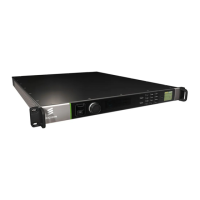6.3 VCM Video Operating Modes
Note: The output of the VCM may contain a discontinuity when the operating
mode (profile, buffer mode etc.) is changed.
6.3.1 Seamless Mode
In Seamless buffer mode, a change in the video bit rate will result in no glitches in
the encoded video. As a tradeoff for the glitch free output video the video quality will
be somewhat reduced.
Any audio configuration is supported when the video is configured for seamless
buffer mode.
When operating in a non-seamless mode the output of the module may be
discontinuous when the bit rate is changed.
6.3.2 Constant Bit Rate (CBR) Mode
The module supports a Constant Bit Rate mode (standard delay).
Any audio configuration is supported when the video is configured for CBR buffer
mode.
6.3.3 Fast Channel Zap
The user can configure the encoder buffer to control the channel change (zap time)
on the decoded output. This mode can also be used to reduce the end to end delay
by setting the Look-ahead to Off. However, picture quality may be affected. This is
targeted for IPTV operation. For that reason, Fast Channel Zap is supported in
H.264 video profiles only and not MPEG-2 profiles.
6.3.4 Capped VBR
The module supports a Capped VBR buffer mode. The encoder will automatically
tune its bit rate within a range specified by the user depending on the picture
complexity. The Target Quality is typically set to 75%, this controls the weighting
algorithm for the picture complexity. A value of 50% will reduce the overall bit rate
for difficult video content and a value of 90% will increase the bit rate for easy video
contents.
6.3.4.1 Operation
In Capped VBR mode, the encoder detects the incoming picture and estimates the
number of bits required to encode that picture. Difficult content requires more bits
and is therefore encoded at a higher bit rate. Easy content requires fewer bits and is
therefore encoded at a lower bit rate.

